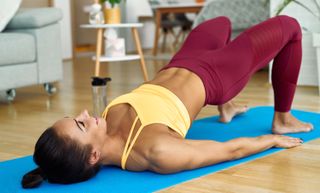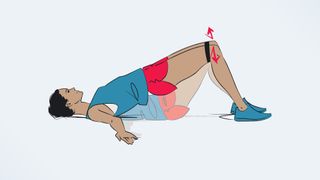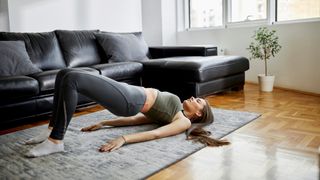I did 50 glute bridges every day for a week — here's what happened
Most of us neglect our glute muscles

I’m a runner and, like many runners, I don’t make the most of the biggest and strongest muscle in the body — the gluteus maximus. I’m equally certain that the other glute muscles — the gluteus medius and the gluteus minimus — are similarly underutilized when I run, and even when I’m standing or walking.
Nor do I pay much attention to my glutes when I go to the gym, aside from a few desultory squats at the end of a session. I try to avoid being in front of a mirror when I do them. There is only so much indignity a man can bear.
So, to increase the stock of human knowledge, and because my editor commanded me, I decided to perform 50 glute bridges every day for a week. I wanted to show those muscles that I still cared and I wondered if the focused exercise would have any effect on my running.
What are the benefits of strong glutes?
The glutes are responsible for moving the hip joint, rotating the legs in and out, and stabilizing the pelvis when we walk, run or balance on one leg. They are also crucial for good posture and stability.
Studies have shown that the gluteus maximus is prone to weakness, which contributes to chronic pain and numerous types of injury. Runners should work on glute strength, as it can help reduce, for example, the incidence of common injuries such as runner’s knee and shin splints. Strong glutes can also improve running performance. In fact, if you are involved in any sport that involves jumping and acceleration, you should work on glute strength. Finally, glutes are crucial for balance, and this becomes increasingly important as we age.
How to do a glute bridge

The glute bridge is a relatively simple exercise to perform. I suggest you use one of the best yoga mats or do it on a soft surface.
- Lie on your back with your knees bent and your feet flat on the ground, hip-width apart.
- Place your hands on the floor by your sides. You are in the right position If you can just about touch the back of your ankle with your fingertips.
- Do not tuck your chin into your chest. You should be looking straight up.
- Press your lower back into the mat, which means you will have to engage your core.
- Squeeze your glutes, press your heels into the mat and raise your hips in a smooth, controlled fashion until you have a straight line from your knees to your hips and on to your chest.
- Resist the temptation to arch your lower back at the top of the exercise. At this point, your knees should be directly over your feet.
- Hold for a second or two, then lower in the same controlled manner, briefly allowing your lower back to touch the mat. That’s one rep.
Here's more on how to do a glute bridge and the different modifications to try.
Sign up to get the BEST of Tom's Guide direct to your inbox.
Get instant access to breaking news, the hottest reviews, great deals and helpful tips.
I did glute bridges every day for a week — here's what happened
Day one
Though simple to do, this is also an easy move to perform badly, so take your time. As I quickly learned, you need to focus on squeezing your glutes. Just raising and lowering your hips is not enough. That was my experience on day one. I knew something wasn’t quite right, as I was feeling the exercise working my hamstrings more than my glutes. It’s true the glute bridge gives those big leg muscles a bit of a workout, but that is not the focus of the move.
I thought it was going to be easy to hit 50 reps on that first day, but I was wrong. After 30 or so, my glutes were beginning to burn and the temptation was to speed up and take a shortcut by not lowering all the way to the mat, but I maintained form and kept my concentration. I hit 50 and when I stood up I felt as if I’d climbed several flights of stairs.
Days two and three
On day two and three, I reached 50 with no real problems, so on day four I decided to raise my arms straight up to make the move more difficult. I did not feel it was harder to maintain form, but I did notice a slight burn deep in my inner thighs, which I imagine was caused by my having to work harder to remain stable. And I felt my core had had a bit of a workout, too.

Days four and five
On days four and five, I tried single-leg glute bridges. This was an eye-opener. By definition, focusing on one side of the glutes is a far more targeted move, but I was surprised by the effort required. I began by raising my hips and then raising my right leg. Do not worry about straightening your leg, as this is not crucial to the effectiveness of the move.
That said, I was disappointed by the tightness in my right hamstring. It just would not straighten. I completed 25 bridge raises, but slowed down considerably for the final few, and felt the burn in my left quad and my core, as well as my left glutes. I found the move slightly easier on the other side (perhaps helped by the fact my left hamstring is not as tight).
Days six and seven
I was impressed by how much work was demanded by this version of the move and so persisted with it for days six and seven. I did the exercise before a run on both days and found it easier than usual to get up to a reasonable pace, presumably because my glutes were already firing and didn’t have to be woken from their slumber.
In general life, I found I was more aware of my posture when sitting and standing, much as I was when I did side planks for a week. Not slouching is surprisingly satisfying.
If you are new to glute bridges, begin with the normal move, but if you are in reasonable shape and already have some experience with the glute bridge, I recommend you try the single-leg variety. You’ll be amazed at how much harder it is to hit your target while maintaining form. It really works. I can’t see myself incorporating the move into my daily workout schedule, but I will definitely do it more often. I mean, who wants to be a slouch?
More from Tom's Guide
John is a writer and editor based in London. He was worked for magazines such as Runner’s World, Men’s Health, Women’s Health and Cosmopolitan. A keen runner, what he lacks in ability he makes up for with enthusiasm and excuses.
